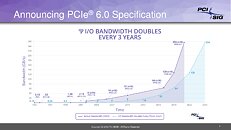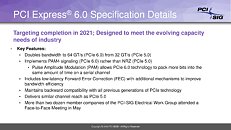- Joined
- Oct 9, 2007
- Messages
- 47,300 (7.53/day)
- Location
- Hyderabad, India
| System Name | RBMK-1000 |
|---|---|
| Processor | AMD Ryzen 7 5700G |
| Motherboard | ASUS ROG Strix B450-E Gaming |
| Cooling | DeepCool Gammax L240 V2 |
| Memory | 2x 8GB G.Skill Sniper X |
| Video Card(s) | Palit GeForce RTX 2080 SUPER GameRock |
| Storage | Western Digital Black NVMe 512GB |
| Display(s) | BenQ 1440p 60 Hz 27-inch |
| Case | Corsair Carbide 100R |
| Audio Device(s) | ASUS SupremeFX S1220A |
| Power Supply | Cooler Master MWE Gold 650W |
| Mouse | ASUS ROG Strix Impact |
| Keyboard | Gamdias Hermes E2 |
| Software | Windows 11 Pro |
The PCI-Express gen 6.0 specification reached an important development milestone, with the publication of its version 0.5 first-draft. This provides important pointers to PCI-SIG members on what features and design changes gen 6.0 hopes to bring, and what its all important number is - bandwidth. PCIe gen 6.0 quadruples per-lane bandwidth over gen 4.0 to 64 GT/s (double that of gen 5.0), resulting in bi-directional bandwidth of 256 GB/s in an x16 configuration.
The spec also introduces a new physical layer change, with PAM4 (pulse amplitude modulation) signaling replacing NRZ (non-return to zero), a key ingredient in the generational bandwidth doubling effort. Despite this, PCIe gen 6.0 retains backwards-compatibility with all older generations of PCIe, which could mean the PCIe slot on motherboards may not look any different. PCIe gen 6.0 also introduces FEC (forward error-correction), and has similar per-channel reach as PCIe gen 5.0. Our older article on Intel's proprietary CXL outlines a key feature of PCIe gen 5.0 besides its bandwidth doubling over gen 4.0 - scalability. Although targeting completion in 2021, it could take several more years for the technology to transcend enterprise computing segments and reach the client. PCI-SIG anticipates the need for gen 6.0 kind of bandwidth in the industry by 2025.


View at TechPowerUp Main Site
The spec also introduces a new physical layer change, with PAM4 (pulse amplitude modulation) signaling replacing NRZ (non-return to zero), a key ingredient in the generational bandwidth doubling effort. Despite this, PCIe gen 6.0 retains backwards-compatibility with all older generations of PCIe, which could mean the PCIe slot on motherboards may not look any different. PCIe gen 6.0 also introduces FEC (forward error-correction), and has similar per-channel reach as PCIe gen 5.0. Our older article on Intel's proprietary CXL outlines a key feature of PCIe gen 5.0 besides its bandwidth doubling over gen 4.0 - scalability. Although targeting completion in 2021, it could take several more years for the technology to transcend enterprise computing segments and reach the client. PCI-SIG anticipates the need for gen 6.0 kind of bandwidth in the industry by 2025.


View at TechPowerUp Main Site





